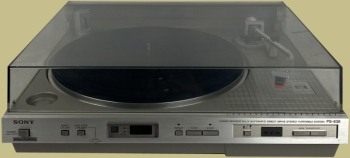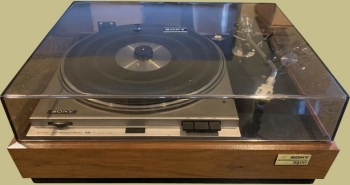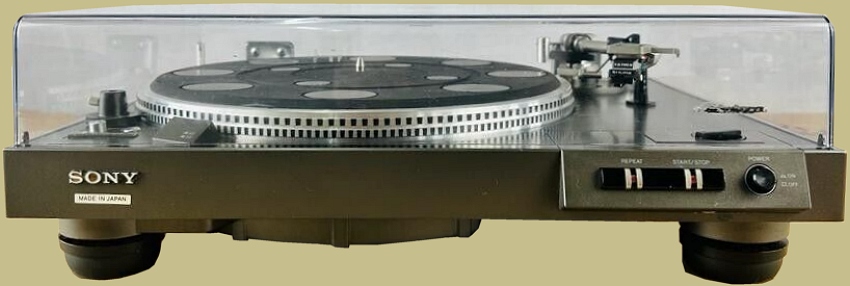
Introduced in 1978 the Sony PS-X6 turntable retailed for a price of $290. It is a two speed, automatic, direct-drive turntable priced at the upper end of the Sony lineup at the time. Other models in Sony’s direct-drive lineup included the PS-X3, PS-X4, PS-X5 and the PS-X7.
The PS-X6 and PS-X7 have touch sensitive controls as well as an optical sensing system to return the tone arm at records end. The PS-X7 has a carbon fiber tone arm and viscous filled rubber platter mat.
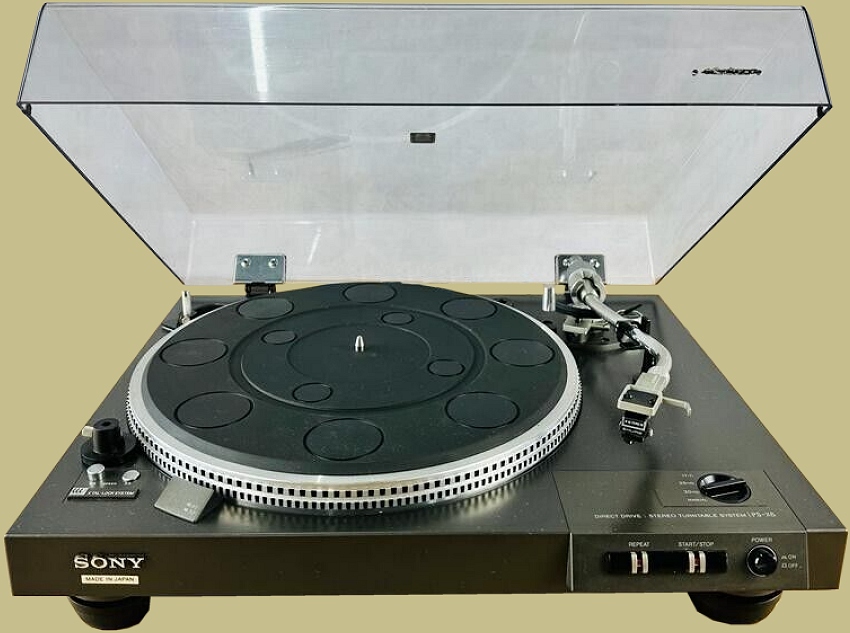
The overall look is simple and tidy, and it comes with a hinged dust cover. The base is made from Sony’s own plastic compound meant to dampen vibrations, and the feet can be adjusted to level it on uneven surfaces.
The controls of the PS-X6 are accessible even with the cover down which is convenient, though the cue lever cannot be used with the cover down.
In full automatic mode, it only takes around 8 seconds after touching Start for the stylus to contact the record. To use it manually, you move the arm where needed and touch the Start/Stop switch, which lowers the arm and starts the platter spinning. At the end of the record, the arm automatically returns to rest. This is triggered by a light sensor so the stylus isn’t pushed.
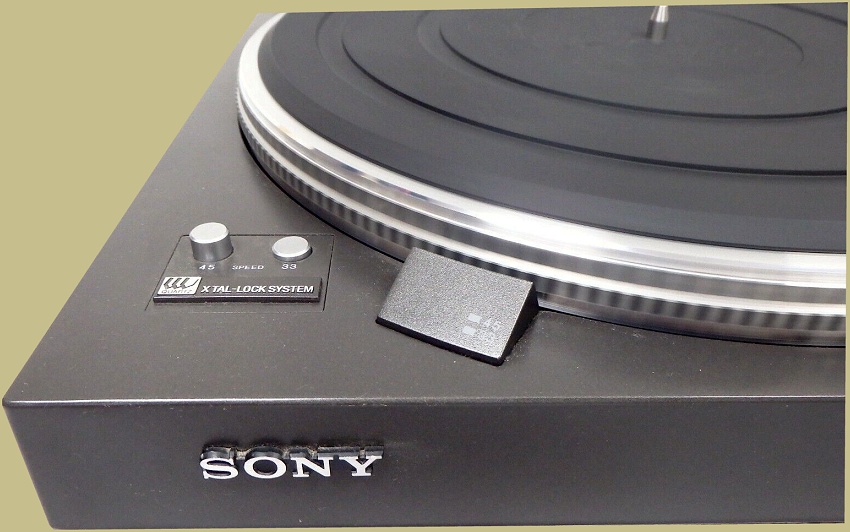
The buttons to select either 33 or 45 rpm speed are to the left of the strobe light.
The turntable spins using a direct-drive motor that is precisely controlled by a quartz crystal oscillator, which helps it rotate at the exact intended speed. The spinning platter has a special magnetic strip bonded to the outer edge that allows a sensor to detect its speed and send feedback to help the motor maintain the right pace. There is a neon strobe light on the front left side that blinks along with the platter’s rotation to visually confirm that the quartz-controlled speed is accurate, even though there is no manual speed adjustment. This neon light is powered by the oscillator itself and not the wall power.
On the right side is an angled panel with two touch-sensitive switches that have LEDs. These control the repeat and start/stop functions. The power switch is next to those, and behind it is a four-position rotation switch. The first three spots on this switch set the automatic arm position for different size records, and the fourth sets it to manual mode.
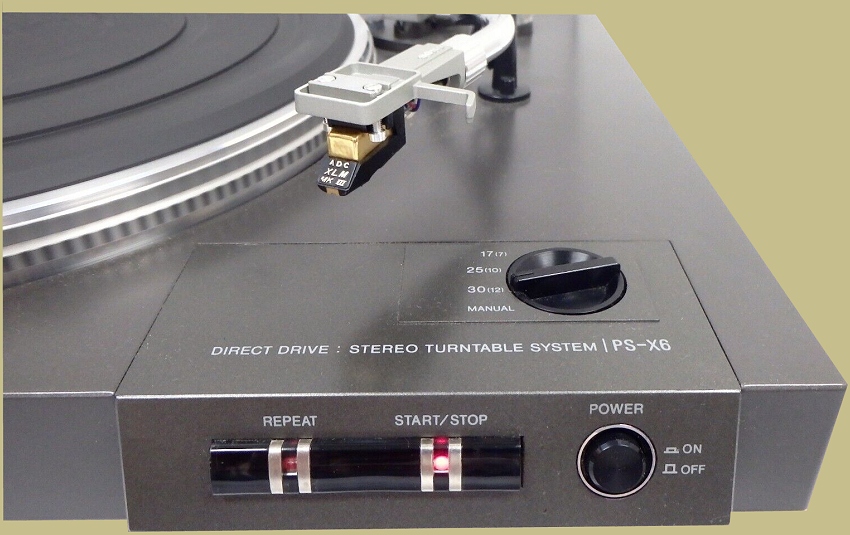
Features
- Automatic lead-in, return, repeat and stop, all activated by electronic touch switches, with LED display.
- Automatic control switches located on front of base, permit dust cover to remain closed during operation.
- Quartz governed X-tal lock servo system for dead-on speed accuracy regardless of load, temperature, or voltage changes.
- Direct drive system with brush-and slot-less (BSL) DC motor.
- High precision speed monitoring system, utilizing 8-pole magnetic pick-up head and pulse coated platter rim for electronic speed sensing.
- Optical sensing mechanism for automatic arm return.
- Statically balanced tonearm with protective clutch device.
- Direct-reading stylus force gauge.
- Viscous damped cueing to raise and lower arm.
- Anti-skating compensation, with direct-reading force adjust ment and lateral balance weight.
- Machine finished, die-cast aluminum platter.
- Quartz governed stroboscope, with engraved strobe markings on platter rim.
- Heavy rubber record mat to minimize vibration.
- Height-adjustable, viscous filled feet for shock and vibration isolation.
- Universal, lightweight headshell.
- Transparent acrylic dust cover, with spring-loaded hinges.
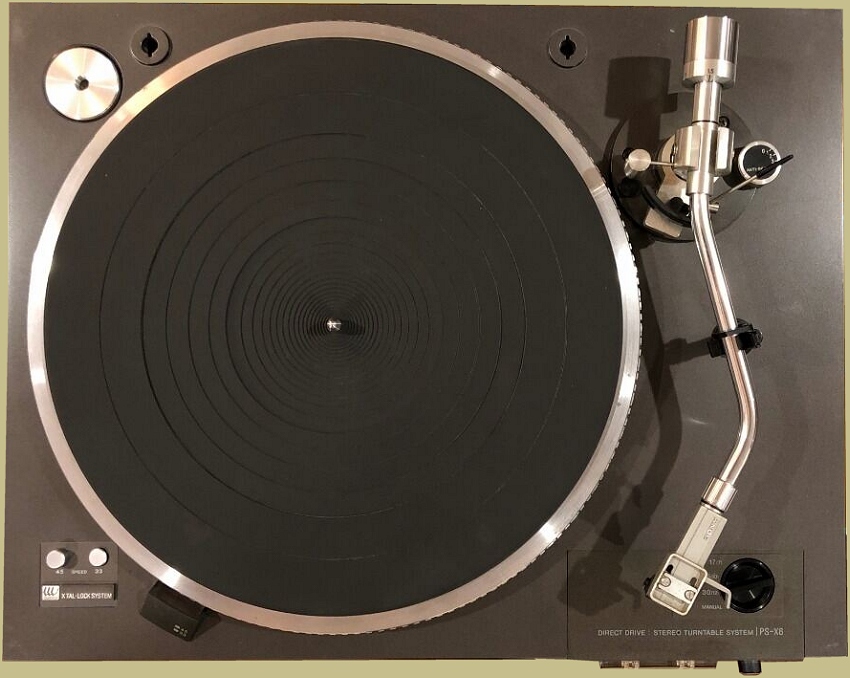
X-Tal System
Sony uses a system they call “X-Tal lock” in the PS-X6 turntable to solve issues related to inconsistent motor speed. This system incorporates a quartz crystal generator that produces a very precise signal frequency. By including phase-lock circuitry that compares the quartz signal to the motor speed, Sony was able to make a drive system with extremely accurate speed control.
The phase-lock circuits constantly monitor any variations or deviations in the motor speed compared to the quartz frequency. When the PS-X6 detects even tiny fluctuations, it instantly makes automatic electronic corrections to lock the motor back to the precise quartz frequency. This means the turntable speed is always dead-on at 33 or 45 rpm, unaffected by changes in the motor load, temperature, or voltage.
Sony also uses advanced speed monitoring technology in the PS-X6. A precision pulse signal is magnetically recorded on the outer edge of the platter. This signal is picked up by a unique 8-pole magnetic pickup head under the platter. By averaging the signals from all 8 poles, Sony achieves highly precise speed detection.
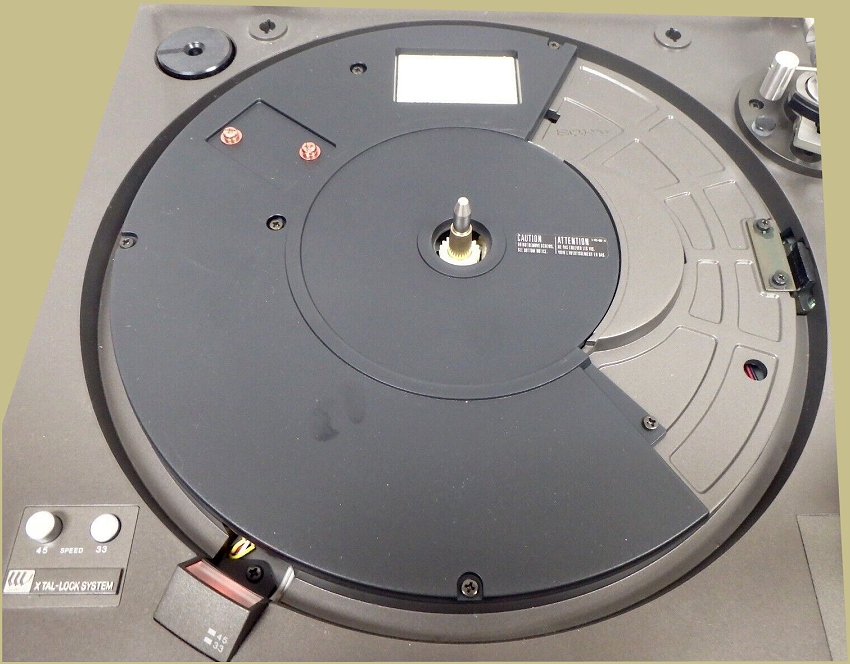
Cabinet
The outer cabinet of the PS-X6 is made from a unique inorganic, non-plastic compound developed by Sony. This material has very low “Q” or resonance properties, meaning it does not tend to amplify vibrations. This makes the cabinet acoustically “dead” so that it does not cause distortion.
The platter itself can also transmit vibrations during playback. To address this, Sony constructed the PS-X6’s platter from a heavy die-cast aluminum alloy which is inherently inert. Additionally, the platter has a thick rubber mat which further damps vibrations.
The height-adjustable feet of the turntable also help isolate it from external vibrations. They contain a special viscous gel that effectively absorbs vibrations from the floor or shelf.
Thanks to all these specially engineered materials minimizing vibrations, the PS-X6 can even be placed directly on top of a speaker that is operating without picking up significant acoustic feedback.
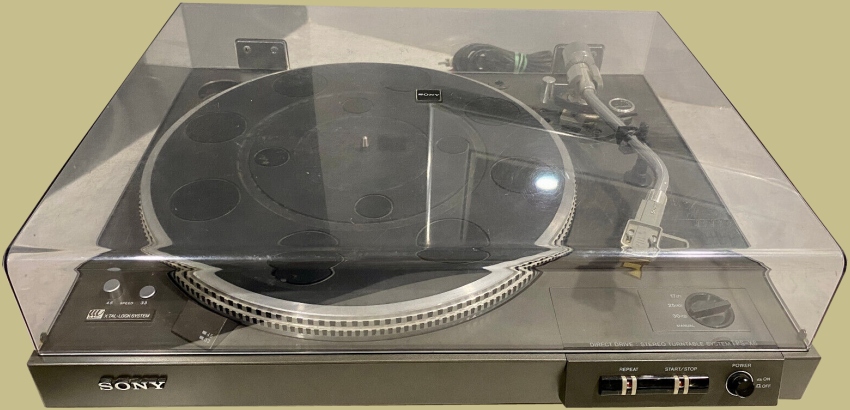
Tone Arm
The tonearm on the PS-X6 is very good. The S-shaped aluminum tonearm provides smooth and precise tracking of the record grooves. It has an ideal low mass that is rigid enough without allowing vibration issues. When used with modern high-compliance cartridges, the resonance between the tonearm and cartridge is kept between 7-9 Hz. This prevents interference with the audio information being read from the record surface.
The SH-145 detachable headshell is made from a special lightweight aluminum alloy Sony developed. This gives it the right balance of stiffness and low mass needed to achieve the excellent resonance levels.
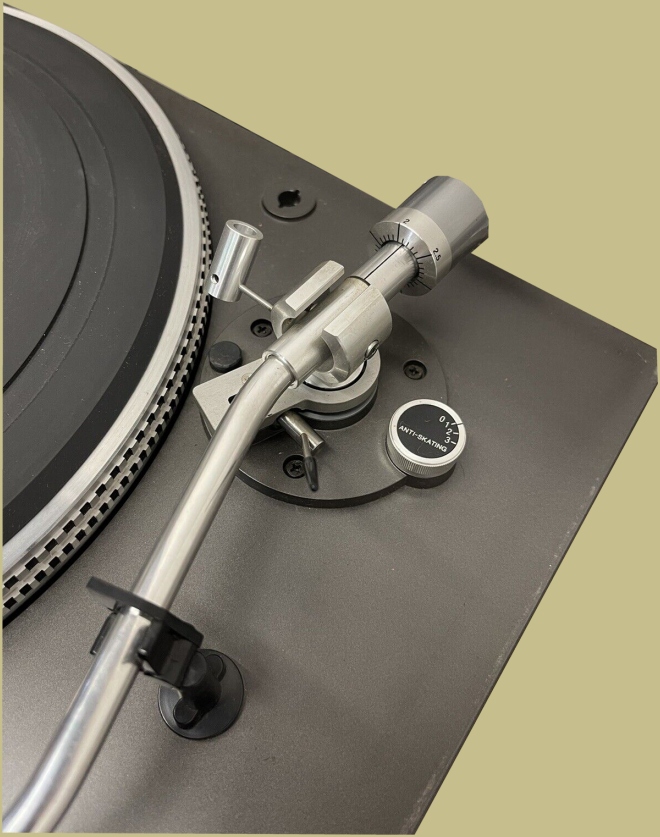
The PS-X6 also employs an optical sensor to detect when the end of the record is reached. This guarantees no side force is applied that could damage the grooves at the end. You can also manually cue the final song without triggering the return mechanism.
The tonearm has a safety clutch that lets you hold it during the record change cycle without harm. Precise anti-skating force and damped cueing are also included.
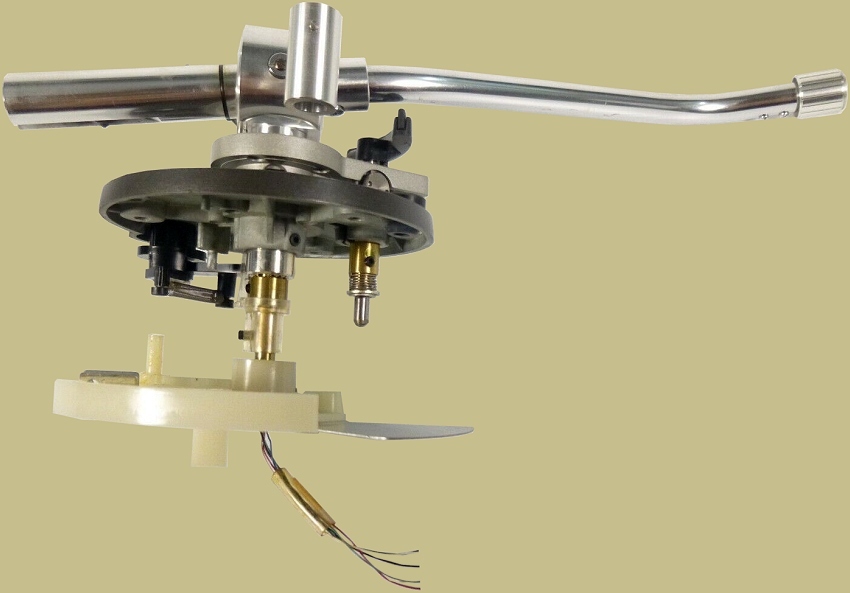
Direct Drive Motor
The PS-X6 uses Sony’s special BSL motor as the core of its smooth servo drive system. Unlike conventional DC motors which have brushes and pole slots that cause cogging and friction noise, the BSL motor in the PS-X6 works without those problems.
Also, since the motor’s drive shaft is directly connected to the platter’s spindle, the PS-X6 eliminates the need for belts, wheels, or pulleys to transfer power.
The BSL motor provides very stable rotation speed. This allows the PS-X6 to achieve wow and flutter measurements of less than 0.025% and rumble of 73 dB, which are very low numbers indicating smooth and quiet operation.
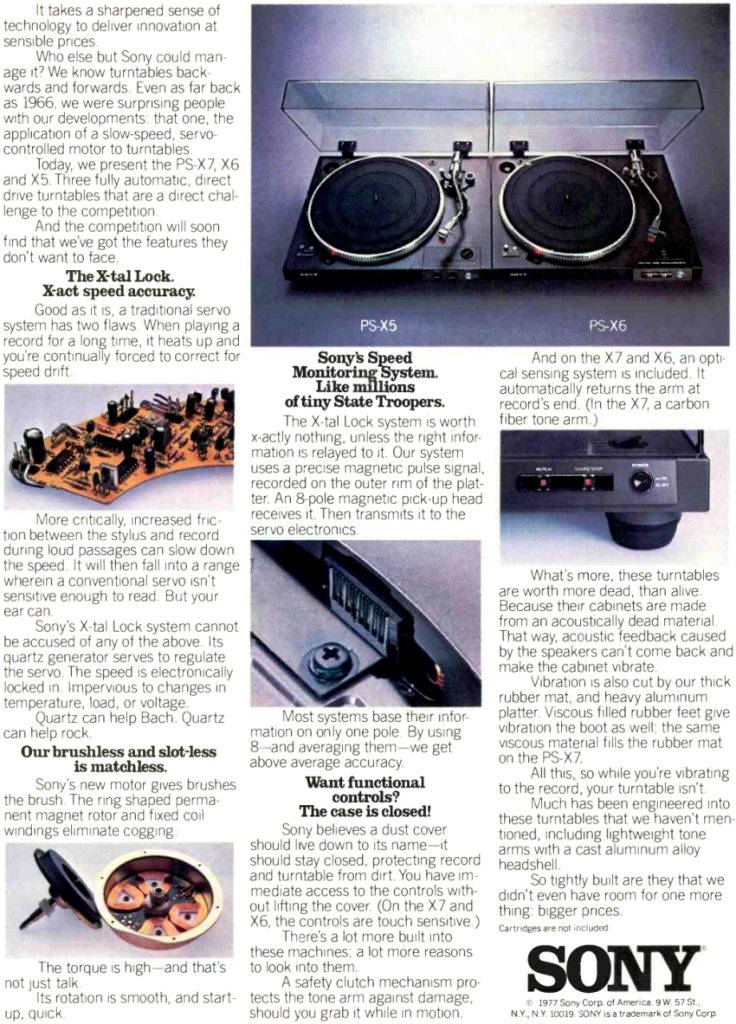
Specifications
- Motor: DC servo controlled
- Drive system: direct drive with crystal lock system
- Signal to noise ratio: 73dB
- Table Speed Accuracy: +/- 0.003%
- Wow &Flutter (WRMS): 0.025%
- S/N Ratio (rumble) (DIN B): 73dB
- Platter Material: Die-cast Aluminum
- Platter Diameter: 12/2″ (31.7cm)
- Platter Weight: 3 lb 8 Oz (1.6kgs)
- Speeds: 33 1/3, 45pm
- Start-up Time (at 33 1/3 rpm): 1/3 rotation
- Tonearm Balance Type: Static
- Pivot-to-Stylus Length: 8 17/32″ (216.5mm)
- Overhang: 21/32″ (16.5mm)
- Stylus Force Range: 0-3 grs
- Anti-skating System: Spring & Cam
- Anti-skating Compensation Range: 0-3 grams
- Arm Resonance: 7-9Hz
- Headshell Weight: 10.5 grams
- Acceptable Cartridge Weight Range: 2.5 to 9.5g (8 to 14.5g with weight)
- Output Cable Capacitance: 70 pfd
- Dimensions (WxHxD): 17 1/2″ x 5 7/8″ x 14 3/4″ (445 x 150 x 375mm)
- Weight: 22 lbs. 8 Oz (10.9kg)
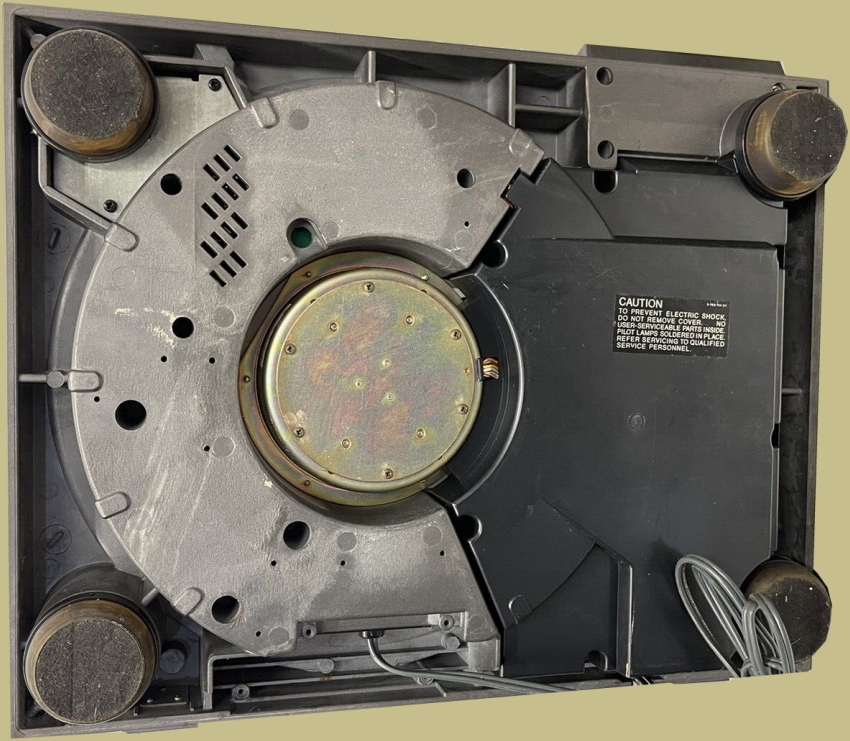
Issues
The PS-X6 does have some common issues. The main problem that occurs is with the speed control. The speed issue can caused by a few things.
- The power supply capacitors may be have gone bad and need replaced.
- The platter rim sensor is malfunctioning.
- The inner platter rim is damaged, scratched, dirty, or stained. The inner rim has a magnetic imprint, if someone washes it, or oils it, or chips it, it throws off the speed.
- The speed trim pot is dirty. Apply a little bit of DeOxit to the speed trim pot on the bottom of the turntable and work it back and forth a number of times. To access it you will need to remove the plastic cover on the bottom of the turntable.
Reviews
Sensational sounding deck with great features.
The whole series of PS-X turntables are great. I have a PS-X4 and a PS-X3. The PS-X6 is worth every penny.
A really good turntable. Very good drive system, good arm and a solid chassis. Good feet too.
The PS-X6 sounds very impressive, images nicely, with three dimensional palpability of instruments and vocalists, and a wonderful sense of depth and space all around the performers.

The Sony PS-X6 turntable may not look like a high-end turntable, and many potential buyers underestimate it, but it performs like one and was designed exceptionally well. The entire lineup of Sony’s PS-X turntables are all good. It’s arguable whether you really need the carbon fiber tone arm on the PS-X7 but the viscous filled platter mat, or ‘Mooney’ mat as some call it is nice. With the exception of occasional speed issues the PS-X6 is well worth consideration if you’re looking for an automatic, direct drive turntable.
